Labyrinth was Jim Henson’s second collaboration with artist Brian Froud, following The Dark Crystal four years earlier. Labyrinth was clearly a very different, more expansive type of project; Henson and Froud were joined by George Lucas as executive producer, Monty Python’s Terry Jones wrote the screenplay, and rock demigod David Bowie signed on to star, as well as write and perform the movie’s soundtrack.
Whereas The Dark Crystal is often seen as Henson and Froud’s freewheeling homage to fantasy àla Tolkien, Labyrinth is much more structured and far more aware of its influences; it’s also wonderfully allusive and meta at points, filled with references to the Brothers Grimm, Hans Christian Andersen, L. Frank Baum, Lewis Carroll, Maurice Sendak, and Walt Disney. And yet the movie doesn’t limit itself to clever references — it’s very clearly participating in the classic tradition of works like The Wizard of Oz, the Alice books, and Where the Wild Things Are, in which a young protagonist escapes a humdrum existence into an exotic, sometimes threatening, alternative reality.
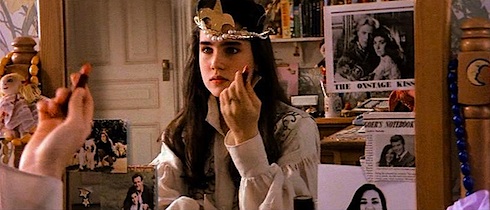
The film opens with our teenaged protagonist, Sarah, lost in her own little world, preferring to hang out in costume reciting plays in the park than she is in “normal” teenaged stuff like dating. The first ten minutes of the movie do a stellar job of setting up Sarah as the heroine of her own suburban fairy tale, the put-upon Cinderella who stomps her way huffily through interactions with her more-exasperated-than-evil stepmother and nice-but-clueless dad. It’s a tribute to Jennifer Connelly’s performance that Sarah manages to exhibit all the hyper-dramatic martyrdom of your average 16-year-old while still seeming sympathetic and likeable — it’s easy to identify with her in the same way that we identify with Alice, or Dorothy Gale, or Sendak’s Max.
Perhaps on some level, the petty tyrannies of bossy adults, no matter how well-meaning, are always going to strike a chord with anyone who’s ever been a kid. In spite of Sarah’s mini-tantrum over having to babysit her baby brother (played by young Toby Froud, whose parents met while working on The Dark Crystal), it’s hard to blame her for feeling unappreciated and angry at not having any say in the matter…except that she is, unexpectedly, given her say. By none other than Mr. David Bowie.
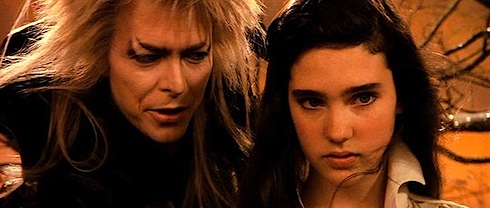
Well, technically, Sarah’s wish is granted by Jareth the Goblin King, who happily complies with her request to spirit the screaming Toby away to his castle, to her immediate regret. She demands that Jareth return the baby, and when she refuses to accept his gifts or be swayed by his arguments, he leaves her at the titular labyrinth, telling her that she has thirteen hours to solve it and rescue her brother, or Toby will remain with the goblins forever. Confidently, even cockily, Sarah sets off on her quest, but soon finds that her expectations thwarted at every turn.
She is consistently frustrated by the bizarre, whimsical, through-the-looking-glass logic of the labyrinth and its inhabitants, fails to ask the right questions, acts on her assumptions rather than facts. She learns the hard way that faeries bite, and that a good many other things in the labyrinth are not what they seem to be. As a friendly worm tells her early on, “You can’t take anything for granted,” and Sarah soon internalizes that advice, learning to think for herself, accepting that she won’t always get her way, facing up to the fact that reality isn’t going to bend itself to her whims. The labyrinth is nothing but a continuous series of choices, but as Sarah finds herself in control of her destiny, she soon realizes that choices can be a tricky, and all decisions have inescapable consequences.
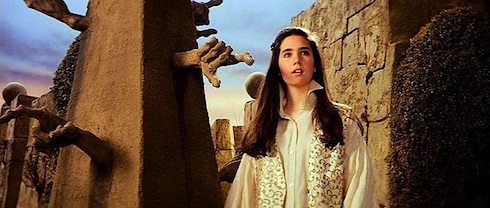
She also begins to make friends along the way, but even that isn’t easy. Sarah’s first companion on the journey is a dwarf named Hoggle, and their relationship is forged through a complicated process of distrust, bonding, betrayal, guilt, and redemption: Girl meets Goblin-like creature, Girl is disgusted by Goblin-like creature and his craven, fairy-killing ways, Goblin helps Girl after girl bribes Goblin, Goblin abandons Girl, then saves her, then double crosses her by means of a spiked peach, finally learns to be heroic and is forgiven. Like everything else in this film, friendship and trust is anything but simple; it’s a learning process, with ups and downs, and entails risk as well as reward.
Meanwhile, as Sarah makes her way through the labyrinth (as well as the series of epiphanies and life lessons lurking around every corner), Jareth watches her progress with increasing displeasure, pouting on his throne while sporting a riding whip and high-heeled boots, as goblin kings are wont to do, and occasionally performing a baby-juggling musical number. As much as I’m tempted to make fun of Bowie’s over-the-top performance (and costumes. And wig and makeup), I actually think he was a brilliant choice for the role. If we think about Labyrinth as a commentary on the role of fantasy in the modern world, a kind of updated fairy tale for the late 20th century, who better to embody the lure of the fantastic than a rock star, especially as one as otherworldly as Ziggy Stardust himself?
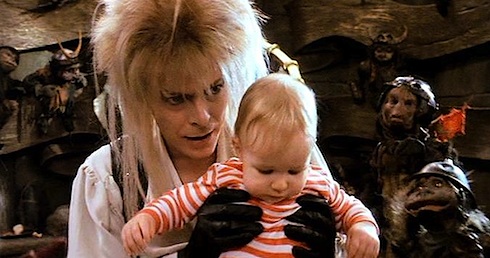
Characters like the Goblin King, or my own personal favorite fairy tale villain, the Snow Queen, tend to represent an unsettling mix of childhood fantasies and adult fears and desires; they draw their would-be victims in through a disturbing blend of infantilization and seduction. Throughout the movie, Jareth attempts to distract Sarah with baubles and gifts, and when that fails, he simply tries ordering her around: “Sarah, go back to your room. Play with your toys and your costumes. Forget about the baby.” Unable to deter her, he has Hoggle slip her the aforementioned poisoned peach, spiked with some sort of potent magical Goblin-roofie.
The resulting hallucination finds Sarah in the midst of what my friends and I always refer to as “Goblin Prom”: dressed in a very grown up, gorgeous ball gown and gloriously big hair, Sarah makes her way through a claustrophobic masquerade ball filled with vaguely threatening masked dancers and Bowie/Jareth, in his best formal glam Goblin King finery. As the soundtrack swells, the sexual undertones of the masquerade are unmistakable — Sarah is clearly the innocent, suffering the smirks and laughter of the debauched, almost predatory revelers swirling around her. She’s the only one not wearing a mask, since even Jareth hides behind several disguises as he quasi-stalks her through the crowd.
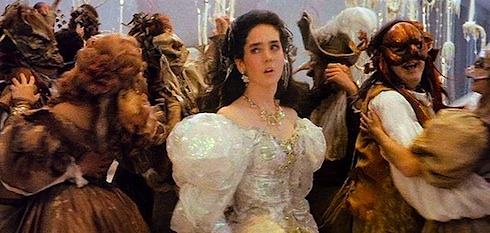
Finally, he reaches her; they begin to dance and as he sings to her, we realize that this is, undeniably, a seduction scene…and something is very wrong. Fighting her way back to reality, Sarah realizes that her time (and Toby’s) is running out, and, in what is simultaneously the worst special effect and the most punk rock moment in the entire film, smashes her way out of Bowie’s smarmy, sexy, smirky distraction-bubble. It’s an amazing sequence — beautiful and unsettling and creepy, and her rejection of Jareth in the scene is powerful precisely because of the uncomfortable juxtaposition of Connelly’s youth and innocence and the much-older Bowie’s rock star magnetism and sinister allure.
The film tends to oscillate between these strategic attempts to distract Sarah by appealing to more selfish, childish desires on one hand and more adult, exotic freedoms on the other. This makes sense the more we realize that the Goblin King is entirely Sarah’s own creation — her belief in him brings him to life, gives him his power, and he needs her imagination and innocence to survive, but she is not prepared to have her whole identity squeezed into an obedient, docile package as a naïve little girl, and not as the prospective Mrs. J. Goblin King, either.
In their final showdown, Jareth offers to fulfill all of Sarah’s dreams, for a price, telling her, “I ask for so little. Just let me rule you, and you can have everything you want.” It’s clear at this point that Sarah must make a choice between the occasionally unpleasant uncertainties and unfairness of life in the real world, or surrender herself to her fantasies by giving up her free will, agency and power, and she barely hesitates before answering, “You have no power over me.” BOOM. Game over, Major Tom.
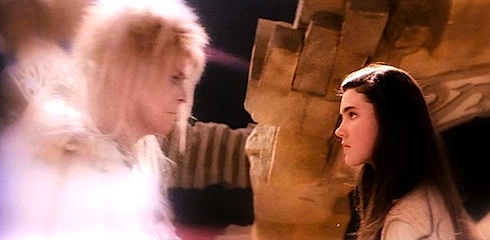
With that one line, balance is restored. Sarah and Toby find themselves safely back at home, and while Sarah is relieved to be back, the movie takes the extra step of assuring her (and the audience), that the world of the labyrinth will always there if she needs it. This has always been one of my favorite aspects of Labyrinth — as much as I see it as a continuing the great coming-of-age-through-fantasy tradition of classic children’s literature, the last scene reassures us that fantasy isn’t necessary meant to be shut out or ignored, any more than reality is. There’s no black and white here: in real life as in the labyrinth, it’s impossible to be a slave to logic. Reality has room for the irrational and the fantastic — life should be a healthy mix of both, and clinging to either extreme is problematic — rejecting reality, or completely rejecting fantasy and imagination are equally unacceptable, by the movie’s reasoning.
I’ve always thought of Labyrinth as the anti-NeverEnding Story (specifically the 1984 film version, not Michael Ende’s original book)—where the power of imagination eventually trumps all in the latter, Labyrinth is all about the balance between the real world and imagination, and about finding joy in both. It’s a sentiment that runs throughout all of Jim Henson’s career, but I’ve always seen it most clearly, here, in his tribute to all the great works of imagination that inspired him along the way.
There are so many amazing things I haven’t had a chance to mention in this film — the truly wonderful script, replete with delightful, Pythonesque touches, the fabulous characters (Ludo! Sir Didymus!), the gorgeous design and puppeteering—but I’m aware that some people love this movie, and others think it’s ridiculous, and there are people in both camps that completely dismiss it as anything but pure camp. And I just have to say that I could not disagree more — I adored Labyrinth as a little kid, and even more as a teenager, then throughout college and I still love it now as an adult, for many, many reasons. But the reason I love it most is that it features a headstrong young female protagonist taking on the world in jeans and sensible shoes.
If that doesn’t sound like much to you, then take into account the fact that the movie revolves around Sarah’s refusal to be treated as a princess (a word never once used in the script). One of the things that this movie does brilliantly is systematically reject the usual “princess” trope — Sarah’s happy ending isn’t going to be found on the arm of some fantasy heartthrob; her adventures in the labyrinth force her to abandon any such princess-y delusions. Her identity is her own, and she isn’t about to be swayed by any bedazzled, leather-loving, tight-panted gigolo with a castle, even if he is some sort of king.
It’s an incredibly subversive approach to the usual fantasy heroine that seems to go unnoticed in the midst of all the muppetry and cleverness and stunning visuals, but to a kid raised on Disney and mediocre sitcoms, it was simply revolutionary, camp or no. In the end, Sarah was allowed to be exactly who she wanted to be — not a child, not an adult, but very much her own person all the same. Labyrinth is a movie about learning to think differently, learning to think for oneself, regardless of people’s expectations, and even more impressively, it’s also a film that practices what it preaches. For that reason, I think that even Alice and Dorothy and Max would agree that this film is, and always will be, a classic.
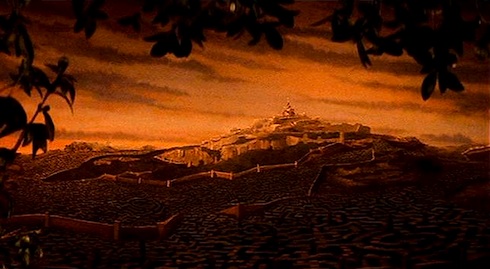
Bridget McGovern would like to apologize to her three younger siblings for repeatedly trying to get the goblins to come and take them all away. Especially since it never worked.










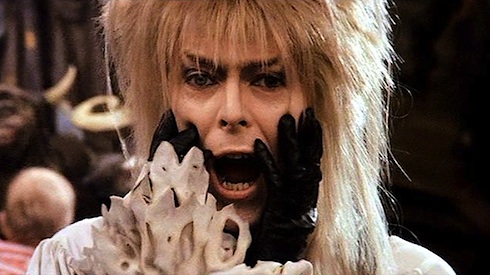
Beautifully written. You captured the masquerade perfectly–this movie came out when I was 11, and I watched it monthly (sometimes weekly) for the next three years or so, and I’m still unsettled by the seduction. Something is very wrong here–but it’s undeniably attractive. Danger, girls, danger!
So many scenes are like this–the fieries, and the garbage lady, in particular, were also representative of a “something’s not right”–is it a party? Are we having fun? Wait, no, danger’s here. Don’t give into illusions, to the crowd–so much of it’s about reality and fantasy AND a great metaphor for growing up and developing identity.
Happy birthday, Jareth! (As a side note, I’ve shown this movie to my young daughters, and the four-year-old sees Jareth and Howl as interchangeable. I think she thinks they’re sequels of each other. Which also, of course, makes a lot of sense.)
Excellent observation on the centrality of personal ownership of imagination and fantasy, subverting the “princess” solution of external adulation. Labyrinth avoids the whole, over-used “chosen one” option, making Sarah’s dilemma and choice much more universal by being much more personal, as we all have our own labyrinths to navigate.
I think you have made your case, Ms. McGovern, for deeming this movie a classic. Of course, it won me over totally just as soon as it used M.C. Escher’s “House of Stairs” as an interior design plan. Never mind the wonderfully ironic aside, “Oh, no, she wouldn’t want to go *that* way. That way leads straight to the castle!”
@1, OMG I never thought of the similiarities between Howl and Jareth, but now I can’t unsee it! And they were BOTH in The Prestige!
David Bowie as Jareth had such an effect on my burgeoning sexuality when I was maturing. But the fact that despite that allure, Sarah resisted him, had an even larger effect on my life.
Perfect. Thank you for this.
This is an interesting analysis, and I don’t want to dispute the points about the film’s thematic merits and empowerment message… but I’m afraid I just don’t like the film at all. I love The Dark Crystal, but I kind of hate Labyrinth. And that largely comes down to the fact that it’s kind of a vanity project built around David Bowie, his look, his sound, etc., which did not work for me at all. He was totally ineffective at conveying any kind of menace, especially with those bouncy dance moves. And I think his singing voice is ugly. When I revisited the movie a few years ago, I found I had to mute the sound during most of the songs. I’m afraid Bowie completely ruins the movie for me. And Jennifer Connelly doesn’t really salvage it, because she hadn’t yet matured into the striking screen presence she would become.
I too love this movie; in some ways I am mildly grumpy about the way David Bowie’s musical career distracts attention from what a phenomenally good actor he is.
Labyrinth also gains a great deal in creepy once you realise the implication that all those other goblins potentially started out as the younger siblings of adolescent girls who didn’t triumph over the Goblin King’s seductions.
“BOOM. Game over, Major Tom.”
Best line I’ve heard/read in weeks!
My daughter (17) loves this movie. We just watched it a couple of months ago and I immediately realized two things: A) that I love being able to bond with her over something that I loved as a kid (so many things just aren’t the same now as they were cough-numbers-mumble years ago) and B) if they did a sequel, David Bowie could probably still pull off the part.
Also, strangeling that I am, any time I hear somebody say, “If you need me…” I auto-update it in my head and hear Hoggle saying, “Yes…should you need us…”
Gets me every time…
Ya, I also love this movie and have watched it quite a few times. I do prefer Dark Crystal though and flims like the Rats of Nihm and so on.
Labyrinth was the movie my sisters loved when we were all growing up. I hated it.
I can admit now that most of my dislike of it came from the fact that it scared me as a kid – the visuals and on-screen happenings were just dream-like enough that I knew I would have nightmares like it and with my own over-active imagination would run wild and keep me up at night.
Because of that underlying fear, I could never see the movie for what it was and could not understand how my three sisters – so seemingly innocent and (to my then 12 year-old brain) “weak” – would watch a show AND enjoy a show that scared their brother. And so I kinda always dismissed it.
That started to change after I got married and found that my wife loved Labyrinth as well. Her well-worn VHS tape was replaced by DVD as we upgraded our collection and I had to start looking at it as something more than just “this was a movie my sisters liked.”
But I never got ANY of what you mentioned here – and I’m astounded. How did I miss all of the themes, the trope subversions, the character development – all of it? And you are absolutely right on all of them. This is a great movie with elements that just can’t be found anywhere else. It has such a great heroine that I’d never seen in that light before.
And maybe that was part of why all the women in my life enjoyed it so much. My mother always supported my sisters watching it. The girls, like you, had the heavy diet princess stories and were constantly exposed to weak female characters. To have such a wonderful portrayal of a strong young woman must have spoke volumes to them.
My older sister especially has always identified with Sarah. She would have been 14 or 15 when we first saw it; physically similar – same dark hair and eyes, similar situations – older sibling stuck watching younger ones, less into “normal teenage girl” things, imaginative, bookish. Suddenly it all starts to make some sense.
Now I’m really excited to sit down and watch this again, let my writer-mind start to pull it apart, and have some wonderful discussions with my sisters to see if they felt about it the same way you describe it here.
Thanks for great article!
I wanted to share this essay I wrote last year–I think the themes are similar to what you’re saying. Mainly for the other Labyrinth buffs. Heaven knows I can’t get enough of reading about it… http://slumberpartymovies.com/2012/08/29/slumber-party-movies-presents-freshman-film-blue-book/
Not to nitpick (and I may be totally wrong) but wasn’t it Hoggle that told Sarah not to take anything for granted? I seem to recall her referencing that advice and saying to herself “Maybe I’m taking it for granted that it just goes on and on” before running some more. That was just before she met the worm.
I loved the whole article. I would only add some quibble:
”
I’ve always thought of Labyrinth as the anti-NeverEnding Story — where the power of imagination eventually trumps all in the latter, Labyrinth is all about the balance between the real world and imagination, and about finding joy in both.”
It might be true about the movie, but balance is the message of the book – Michael Ende was reportedly unhappy with the adaptation of his novel.
Anyway, great article, I can only recommend it!
@11
It’s not phrased as advice, but yes Hoggle does say “You know what your problem is? You take too many things for granted. Take this labyrinth for instance.” The worm echoes the sentiment.
@5
If Bowie doesn’t work for you at all, the movie won’t work for you. And Henson always intended the Goblin King to be a pop star with singing and dancing (Michael Jackson and Sting were other possibilities). Terry Jones actually always disliked that aspect of the film; he didn’t think that the story should cut to the center of the labyrinth for song and dance numbers before Sarah got there herself.
@13: It would’ve been even worse with Michael Jackson, I think — no way could he have played a convincing menace. Sting seems a more plausible candidate — he was Feyd in Lynch’s Dune, after all — but I’m not familiar enough with his music to know whether I could stand listening to it.
I think I’m with Mr. Jones on this one, though. Let it be Sarah’s journey of discovery with us following along, rather than compromising that for the commercial reason of showing off the famous pop star.
Thank you for this – it’s very lucidly expressed and it’s always great to see more acknowledgement of what a wonderful film Labyrinth is (this line, especially, is great: “But the reason I love it most is that it features a headstrong young female protagonist taking on the world in jeans and sensible shoes”). While I understand why it happens, I dislike it when Labyrinth is dismissed as throw-away camp. It’s been a very important movie for me and I know many other girls and young women who feel the same – Labyrinth showed them a heroine who existed on her own terms, a young woman who felt unhappy with her hundrum existence, made a mistake and then set out to put things right. Sarah is often labelled a brat, but nothing could be further from the truth – she’s a human being, and while far from a perfect angel she’s brave and determined. She’s an excellent role model and I wish there were more youth-orientated films with heroines like her.
Hedgehog Dan — Ende was unhappy because the film covers just the first half of his novel. It’s fairly accurate to the novel but makes little sense without what comes after where it stops.
Hedgehog Dan — Ende was unhappy because the film covers just the first half of his novel. It’s fairly accurate to the novel but makes little sense without what comes after where it stops.
This is a lovely article, and captures a great deal of what I adore about Labyrinth. One tiny – I don’t even want to call it a nit-pick, but a question: you reference Sendak’s influence on the film’s style and compare it to Where the Wild Things Are, and I have to wonder why that’s the book you see as a referent when I’ve always thought that Outside Over There was a far more conspicuous source, in terms of visual style as well as plot.
Yes.
@18, There is a lingering shot of Where the Wild Things Are as the camera pans through Sarah’s room, so I assume the connection is an intentional one.
I suspect they wanted a pop star to play the Goblin King because it fit the concept of a character who is alluring but ultimately superficial with no power over Sarah beyond what she allows.
Hello, all–thanks for all the comments, and sorry for not chiming in sooner. The decision to republish this post was a bit last-minute (you know when you wake up and realize it’s David Bowie’s birthday again and you forgot to get him anything? Awkward). When it originally ran back in 2012, I meant to clarify that I was specifically talking about the ending of The NeverEnding Story movie that came out two years before Labyrinth and not Ende’s original novel (which I read as an adult, and is stranger and more interesting and certainly quite different in many ways from the film adaptation). I’ll put a note to that effect in the post now, just to avoid any further confusion–thanks!
And just to quickly address another oversight–Julia M-K @18, that’s an excellent point. As Aeryl points out, I always specifically noticed the copy of Where the Wild Things Are (it always jumped out at me, since it was another childhood obsession and my own room certainly featured a shelf of Wild Thing stuffed animals :), but Sendak’s Outside Over There was clearly a major inspiration for this film, absolutely!
i have always loved this movie. I still love it today as an adult of 36. There’s just something timeless about this movie. When I watched it as an adult, I noticed so much more in her room. Many of the creatures and senarios are there to find in the keen eye.
This is such a great article.
Goodness, you articulated it all so well! Why this movie really is a masterpeice and exactly the type of movie young girls should be watching instead of those typical cartoons where the princess is always at the mercy of someone and waiting to be rescued.
I have always loved the Labyrinth and remains a favorite to this day! Oh yes and the sountrack rocks – I still listen to it on a weekly basis as background noise while working.
I feel so close to the author of this article right now. Never have I read a review that so perfectly captures why I love something. I’m a reader, not a writer. Words do not flow out of my mind, mouth, or fingertips with ease and skill. What is in my head is such a mixture of emotions that I can rarely verbalize my feelings for things that I love. This article has done that for me and so much more. It has made me realize many of the little things that I love about this movie in such an articulated, concise way, that I feel as though the movie is new to me all over again! Thank you, Ms. McGovern, for that feeling.
This is beautifully written, one of my all time favs (and first crush). I never read things all way through on the internet but i was mesmorised by your words, and completely agree. Its one that me and my siblings still watch together. Sometimes i ring my sissypoos and all i have to say is “you remind me of the babe…..” and she replies.
Thankyou for your words :)
Again, thanks so much for the lovely comments–it’s so gratifying to get this kind of positive feedback on a post, especially when you have a personal stake in the subject matter. It’s no surprise that Labyrinth still has a quite a following, of course, but it’s really wonderful to hear from fellow fans who feel the same way about the film :)